
Vauxhall's new and more compact four-cylinder saloon car, the Victor F, made its first appearance in March 1957.
 Considerably smaller than the Wyvern VIX that it was replacing, Vauxhall’s marketing team were aiming directly at those motorists who wished for a comfortably roomy but compact four-seater model providing better than average performance rather than the inexpensive but quite large six-seater four-cylinder models generally available.
Considerably smaller than the Wyvern VIX that it was replacing, Vauxhall’s marketing team were aiming directly at those motorists who wished for a comfortably roomy but compact four-seater model providing better than average performance rather than the inexpensive but quite large six-seater four-cylinder models generally available.
 A large glass area was the car's most notable feature, with the "panoramic" windscreen, already established in the United States, making its first appearance on a British car. The screen's development reportedly played an essential part in the development of the Victor.
A large glass area was the car's most notable feature, with the "panoramic" windscreen, already established in the United States, making its first appearance on a British car. The screen's development reportedly played an essential part in the development of the Victor.
 Both the front and rear wings bulged outward at their lower edges to meet with similar forward protruding bulges at the extremities of the bumper bars.
Both the front and rear wings bulged outward at their lower edges to meet with similar forward protruding bulges at the extremities of the bumper bars.
The low and full-width grille housed the sidelights and was also styled to blend in with the bumper, while at the rear, the sidelight surrounds appeared as vertical extensions of the bumper extremities.
![]()
The front wings again bulged outwards above wheel arch level, at the point where the Vauxhall flutes were situated.
 The Victor Super, in effect a deluxe edition of the model came with a bright metal finish on all the window surrounds, while the exhaust system tailpipe created a dramatic effect by winding up inside the offside bulge in the bumper.
The Victor Super, in effect a deluxe edition of the model came with a bright metal finish on all the window surrounds, while the exhaust system tailpipe created a dramatic effect by winding up inside the offside bulge in the bumper.
 Despite the intrusion into the front door space by the reversed slope windscreen pillars, the Victor F’s doors still featured opening quarter windows.
Despite the intrusion into the front door space by the reversed slope windscreen pillars, the Victor F’s doors still featured opening quarter windows.
Although very definitely a four-seater only, a bench seat was provided in the front. Both seats were devoid of armrests, even in the Super version.
 The Super did, however, feature armrests and door pulls all round, a half horn ring on the steering wheel, twin sun visors and door-switch-operated interior lighting.
The Super did, however, feature armrests and door pulls all round, a half horn ring on the steering wheel, twin sun visors and door-switch-operated interior lighting.
Two-speed electric windscreen wipers were a standard fitting on both models, although they notoriously frustrated drivers as, initially, the timing arrangement on them was “out of kilter” leaving a sizeable unswept area in the centre of the screen.
Surprisingly though may it seem, in chilly Britain, heaters were only available as an optional extra in the Victor F series.
![]()
 A very transatlantic-looking facia faced the occupants, with a glovebox and parcel shelf ahead of the passenger while the driver viewed the speedometer, engine temperature gauge, and fuel gauge through the upper half of the steering wheel cover making it particularly easy to read.
A very transatlantic-looking facia faced the occupants, with a glovebox and parcel shelf ahead of the passenger while the driver viewed the speedometer, engine temperature gauge, and fuel gauge through the upper half of the steering wheel cover making it particularly easy to read.
A two colour interior treatment was available for both models, but only in a grey and black combination with a cream headlining on the standard version of the Victor F, whereas three interior choices were available on the Super.
Although fitted the same bore and stroke measurements as in the Wyvern, 79.4 x 76.2mm, the Victor F Type’s 1508cc engine was otherwise almost wholly new.
 A new cylinder block now terminated well below the crankshaft centreline, and the cylinder head now featured equal length holding-down bolts.
A new cylinder block now terminated well below the crankshaft centreline, and the cylinder head now featured equal length holding-down bolts.
These changes resulted in a useful increase in the stiffness of the unit as a whole, and the Victor engine was destined to gain an enviable reputation for longevity by four-cylinder standards
Take me back to the home page


